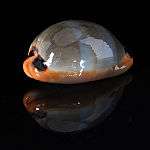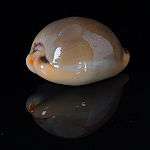Luria lurida
Luria lurida is a species of sea snail, a cowry, a marine gastropod mollusk in the family Cypraeidae, the cowries.[1]
| Luria lurida | |
|---|---|
| A shell of Luria lurida from Sicily, anterior end towards the right | |
| Scientific classification | |
| Kingdom: | |
| Phylum: | |
| Class: | |
| (unranked): | |
| Superfamily: | |
| Family: | |
| Genus: | |
| Species: | L. lurida |
| Binomial name | |
| Luria lurida | |
| Synonyms[1] | |
Description
The shells of Luria lurida reach on average 40–48 millimetres (1.6–1.9 in)of length, with a minimum size of 14 millimetres (0.55 in) and a maximum size of 66 millimetres (2.6 in). The dorsum surface of these elongated, smooth and shiny shells is mainly pale brown or reddish, with three transversal darker bands alternating with narrower clearer bands. At the extremities of the shell there are two separate dark brown spots. The aperture is wide, with several teeth. In the living cowries the mantle is dark brown and may cover the entire shell. The male is usually smaller and elongated than the female.
A shell of Luria lurida from Sicily, lateral view, anterior end towards the right |
Dorsal view of a shell of Luria lurida from Sicily, dorsal view, anterior end towards the right |
Distribution
This common species is distributed in Mediterranean Sea and in the seas along Cape Verde, Azores, Canaries and West Africa, mainly in Senegal and Angola.
Habitat
As they fear the light, during the day usually they hide themselves in small caves, crevices or under rocks up to about 40 metres (130 ft)of depth. They live on rocky seabed and corals, feeding during the night mainly on sponges of Verongia aerophoba, Aiplysina aerophoba, Chondrilla nucula and Tethya aurantium.
Subspecies
Three subspecies have been recognized :[1]
- Luria lurida pulchroides Alvardo & Alvarez, 1964
- Luria lurida lurida (Linnaeus, 1758)
- Luria lurida minima (Dunker, 1853)
 Lateral view of a shell of Luria lurida pulchroides, anterior end to the right |
 Lateral view of a shell of Luria lurida lurida, anterior end to the right |
References
- Luria lurida (Linnaeus, 1758). Gofas, S. (2009). Luria lurida (Linnaeus, 1758). In: Bouchet, P.; Gofas, S.; Rosenberg, G. World Marine Mollusca database. Accessed through the World Register of Marine Species at http://www.marinespecies.org/aphia.php?p=taxdetails&id=139499 on 17 October 2010 .
- Gofas, S.; Le Renard, J.; Bouchet, P. (2001). Mollusca, in: Costello, M.J. et al. (Ed.) (2001). European register of marine species: a check-list of the marine species in Europe and a bibliography of guides to their identification. Collection Patrimoines Naturels, 50: pp. 180–213
- Rolán E., 2005. Malacological Fauna From The Cape Verde Archipelago. Part 1, Polyplacophora and Gastropoda
- Repetto G., Orlando F. & Arduino G. (2005): Conchiglie del Mediterraneo, Amici del Museo "Federico Eusebio", Alba, Italy [as Luria lurida (Linné, 1758)]
- Prats Pi, L. (2002): Gastròpodes marins de la cala de Binissafúller, Menorca (Illes Balears) Molluscat, Spira, 1(2): 21-24 [as Lurida lurida (Linnaeus, 1758)]
- Doneddu M. 1999. Some notes about range, habitat and ecology of the Mediterranean species of Cypraeidae. The Festivus 31 ( 8 ): 87-91. San Diego
External links
- Biolib
- Sea-shell
- Flmnh
- "Luria lurida pulchroides". Gastropods.com. Retrieved 16 January 2019.
| Wikimedia Commons has media related to Luria lurida. |